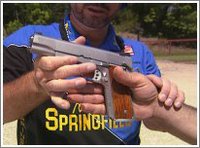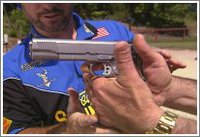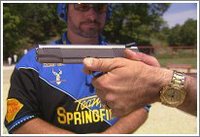Get a Grip
I haven't written about the Dan McKown story before because I was waiting to see how it panned out. It now seems like he's going to be alright, at least in the sense that he isn't in any immediate danger of death.
It seems his story has inspired some among us to examine the level of training and proficiency they have and assess how well they'd be able to defend themselves.
I know I have.
I mentioned at Mr. C's that I have a problem with catching my dropped mags before I reload my weapon. It's a habit I picked up at the range, where cracking a mag base would piss me off, but is totally unsuited for tactical environments, where the extra second or two might get me killed. There are a couple of other things that I need to work on in regards to drawing from concealment and effectively clearing a malfunction, but my stance and grip are good.
So good, in fact, that I'm going to share. Some may use these techniques, some may not, some may want to try it out.
The Grip
Recently, my shooting grip improved exponentially. I was in the company of a former Army Ranger officer at a range and he took note of my situation and lent a hand. The grip that he taught me - and that I have now burned into muscle memory - was simultaneously the most comfortable, stable and accurate that I had used. It works perfectly for medium and large frame autos as well as some, not all, revolvers.
Coincidentally, Rob Leatham uses the same grip. Pics are borrowed from that site.
 Start by grasping the pistol in the back of your strong hand. Make sure the meaty part of your palm is contacting as much of the backstrap and grip as possible. Wrap your fingers around the grip, leaving your index finger outside of the guard of course. Your thumb should rest on the safety (1911), cylinder latch (revolver) or bevel of the frame for most other autos. The gun should be low in the hand, with your index finger as close to the line of the bore as possible. This will allow better pointability as well as allowing your whole arm to absorb the recoil as opposed to just the wrist.
Start by grasping the pistol in the back of your strong hand. Make sure the meaty part of your palm is contacting as much of the backstrap and grip as possible. Wrap your fingers around the grip, leaving your index finger outside of the guard of course. Your thumb should rest on the safety (1911), cylinder latch (revolver) or bevel of the frame for most other autos. The gun should be low in the hand, with your index finger as close to the line of the bore as possible. This will allow better pointability as well as allowing your whole arm to absorb the recoil as opposed to just the wrist. With your weak hand, grasp the grip and wrap your fingers around your other hand. Make sure the meaty part of your palm is pressing firmly into the grip. Your palms should be flush together, not overlapping at all. Your weak hand will be pressing the gun into your strong hand and creating tension in your arms. Place the weak side thumb forward on the pistol, on the front of the slide stop or along the top of the frame for most autos, along the frame under the cylinder for revolvers. Your thumbs should how both be pointing forward, towards the target. Your hands will have a firm, uncompromising grip on the pistol, and your forearms will be tight. You'll notice that as you bring the weapon up, it naturally comes to rest at a point of aim level with your own chest - or an assailants center mass.
With your weak hand, grasp the grip and wrap your fingers around your other hand. Make sure the meaty part of your palm is pressing firmly into the grip. Your palms should be flush together, not overlapping at all. Your weak hand will be pressing the gun into your strong hand and creating tension in your arms. Place the weak side thumb forward on the pistol, on the front of the slide stop or along the top of the frame for most autos, along the frame under the cylinder for revolvers. Your thumbs should how both be pointing forward, towards the target. Your hands will have a firm, uncompromising grip on the pistol, and your forearms will be tight. You'll notice that as you bring the weapon up, it naturally comes to rest at a point of aim level with your own chest - or an assailants center mass. The pressure that you're exerting with either hand will make it much easier to engage multiple targets on multiple planes without having to shift your grip or stance. The tension in your grip and arms will naturally bring the weapon down to the firing position efficiently. You may notice the advantage of this type of grip when you are doing rapid centerfire shooting - you will be able to shoot faster and more accurately.
The pressure that you're exerting with either hand will make it much easier to engage multiple targets on multiple planes without having to shift your grip or stance. The tension in your grip and arms will naturally bring the weapon down to the firing position efficiently. You may notice the advantage of this type of grip when you are doing rapid centerfire shooting - you will be able to shoot faster and more accurately.Caveat: Your weak hand thumb could concievably release the slide stop and prevent it from locking the slide back. After practicing, the effect has been negated for me, but it happened when I first tried it.
The Stance
Stand up. Try this.
Open your stance up so that your feet are about shoulder width and parallel to each other.
Bend your knees a little bit and allow your calf muscles to take the weight of your body and lean forward very slightly.
That's the shooting stance. The same guy that showed me the grip showed me that stance. There are two simple things it incorporates - ease of access to your holster and good mobility. When you're wearing a gun, drop into that stance. It pushes the butt of your pistol away from your body ever so slightly, allowing you a cleaner draw, unless you carry IWB or SOB. It also allows you to move around more. You can move forward and backwards more quickly because one foot is not already behind the other. There is no need to gather yourself and push off in the direction you want to go. You simply go. Its easier to move side to side when your feet are parallel, too. And you can drop into a crouch immediately, which is more difficult when one foot is slightly behind you.
By combining that stance and that grip, I became a better shooter almost overnight. With some much needed trigger control on top of that, I have discovered a much more valuable and tactically sound shooting style. Just thought I'd share and spread the word that that Ranger passed to me. Try it out if your so inclined, and let me know what other things work or don't work for you.
Cheers.






